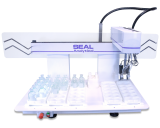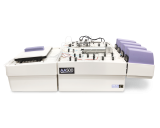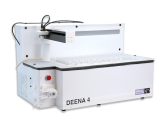Conductivity (EC)
Conductivity analysis is essential for detecting contamination, assessing salinity, and ensuring regulatory compliance in environmental and industrial applications. Automation improves accuracy, increases throughput, and enables simultaneous analysis of pH, alkalinity, turbidity, and color. SEAL Analytical’s advanced solutions streamline workflows, delivering reliable, high-quality data for high-volume laboratories.
Why is Conductivity Testing Important?
Conductivity testing is a fundamental step in environmental and water quality analysis, providing critical insights into the presence and concentration of dissolved ionic substances. As a key indicator of salinity and contamination, electrical conductivity (EC) measurements are essential for evaluating water quality across diverse applications—from monitoring rivers, lakes, and estuaries to ensuring compliance with wastewater and industrial discharge regulations. Elevated conductivity levels can signal pollution from agricultural runoff, industrial effluents, or untreated wastewater, making this analysis essential to environmental protection and sustainability efforts.
In large-scale laboratories, conductivity testing is often a preliminary step for nutrient analysis, helping scientists assess water suitability for applications like irrigation, drinking water safety, and ecological health monitoring. For agricultural and soil sciences, conductivity measurements inform decisions on irrigation practices, soil salinity management, and fertilizer optimization. In wastewater treatment facilities, conductivity analysis tracks ion concentrations to ensure treatment efficiency and regulatory compliance, while also supporting sustainable discharge practices that minimize ecological harm.
SEAL Analytical’s expertise in automated conductivity testing delivers incredible precision and efficiency, empowering laboratories to handle high-throughput workflows with ease. Whether analyzing conductivity in soil extracts, natural water bodies, or industrial effluents, automation enhances accuracy, reduces hands-on time, and ensures reproducible results. By integrating conductivity testing with other analytical methods like pH, alkalinity, turbidity, and color, SEAL's automated solutions help laboratories streamline operations, optimize processes, and generate reliable data to meet the demands of modern environmental and industrial testing.
What's the Automation Advantage?
| 1. Increased Efficiency and Throughput: Automation enables laboratories to streamline conductivity testing, handling large sample volumes with consistent accuracy. By reducing the time spent on manual measurements, laboratories can increase throughput and focus on more complex or value-driven tasks, optimizing overall productivity. | 2. Multi-Parameter Integration: Conductivity testing can be easily automated alongside other essential analyses, such as pH, alkalinity, turbidity, and color. This integrated approach saves time, simplifies workflows, and maximizes the utility of automated laboratory equipment, making it an ideal solution for high-demand laboratories. | |
| 3. Reduction of Human Error:Automated systems ensure precise, repeatable conductivity measurements by eliminating inconsistencies caused by human error. This level of accuracy not only enhances data reliability but also reduces the need for retesting, saving both time and resources. | 4. Seamless Integration with LIMS: SEAL's software packages offer customizable data exports compatible with any Laboratory Information Management System (LIMS), enabling streamlined data transfer and better coordination of testing results within larger laboratory infrastructures. |
SEAL's Expertise in Automated Conductivity Analysis
With over 35 years of experience in developing advanced robotic handling platforms, SEAL Analytical stands at the forefront of automated conductivity analysis. Designed and manufactured at SEAL Analytical Netherlands (formerly ROHASYS), our MiniLab series is designed to deliver unmatched precision and efficiency. These platforms not only streamline conductivity testing but also support simultaneous analysis of other key parameters, such as pH, alkalinity, turbidity, and color, ensuring comprehensive results in a single workflow.
SEAL’s demonstrated robust engineering is evident in every system we produce, from sturdy frame designs that maintain precise alignment to mechanics optimized for repeatable accuracy. This dedication ensures that laboratories achieve consistent, high-quality data, whether analyzing environmental water samples, industrial effluents, or agricultural extracts. By combining decades of expertise with cutting-edge innovation, SEAL Analytical continues to set the standard for reliable, scalable solutions in automated conductivity analysis and beyond.
Key Conductivity Methods and Features
SEAL Analytical’s expertise in conductivity analysis coincides with approved methods. Common reference methods include:
In addition to conductivity measurement, SEAL Analytical’s MiniLab systems support an array of automated processes, including barcode scanning, filtration, dilution, addition of buffers and extract solutions, pH adjustment, and measurement of pH, turbidity, alkalinity, and color in a single run.
Compare our Analyzers
Explore the capabilities of each of our product lines below. Our analyzers and robotic systems are capable of analyzing a wide variety of analytes on a single platform. Select a product line to learn more about the capabilities of each system.
Ready to Optimize Your Conductivity Analysis?
Request Information
Fill out the form below to request information about our products and services.


.png?resolution=160x128&quality=95)

